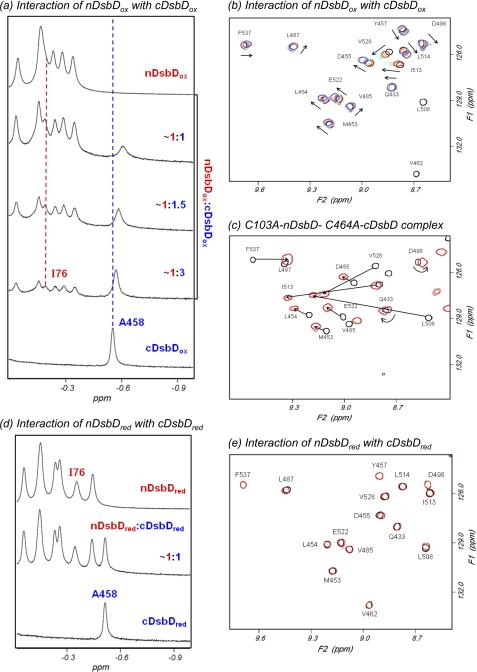FIGURE 2.
750-MHz NMR spectra of cDsbD and nDsbD show oxidation state-dependent interactions. a, titration of cDsbDox with nDsbDox, monitored by one-dimensional 1H NMR, shows fast exchange on the NMR time scale. Stepwise additions of a 1.2 mm solution of nDsbDox to a ∼0.3 mm solution of cDsbDox were made. The nDsbD concentrations were 0.09, 0.17, and 0.30 mm. As nDsbD is added, the peak corresponding to Ala458 Hβ from cDsbD broadens and shifts upfield. The peak corresponding to Ile76 Hδ of nDsbD shows similar behavior. b, two-dimensional 1H-15N HSQC spectra of mixtures of [15N]cDsbDox and unlabeled nDsbDox allow the titration to be monitored at the residue-specific level. HSQC spectra were obtained during the titration of 0.3 mm [15N]cDsbDox with nDsbDox. Spectra with 0.00 (black), 0.09 (red), 0.17 (orange), 0.24 (cyan), and 0.30 mm (violet) nDsbD are shown. The arrows indicate the direction in which the peaks shift in the course of the titration. Peaks arising from Val462 and Leu508 broaden beyond detection upon the addition of 0.09 mm nDsbDox, indicating a more significant perturbation for these residues. c, overlay of HSQC spectra of [15N]C464A-cDsbD (black) and the covalent C103A-nDsbD-[15N]C464A-cDsbD complex (red) at 313 K. Peaks arising from the same residues in the two species are connected by an arrow and are labeled. In the covalent complex, peaks shift in a direction similar to that observed in b, but the magnitude of the shifts is larger in the covalent complex. d and e, cDsbDred and nDsbDred do not show a detectable interaction. d, this spectrum was obtained after the addition of 15 mm DTT to the ∼1:1 mixture of oxidized proteins shown in a, resulting in a spectrum equivalent to the sum of the spectra of isolated cDsbDred and nDsbDred. e, overlay of two-dimensional 1H-15N HSQC spectra of [15N]cDsbDred (black) and the ∼1:1 mixture of [15N]cDsbDred and nDsbDred (red) shown in d. No significant broadening or peak shifts are observed, indicating that cDsbDred and nDsbDred do not show a measurable interaction with each other.

